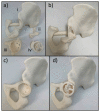Surgical Advances in Osteosarcoma
- PMID: 33494243
- PMCID: PMC7864509
- DOI: 10.3390/cancers13030388
Surgical Advances in Osteosarcoma
Abstract
Osteosarcoma (OS) is the most common primary bone cancer in children and, unfortunately, is associated with poor survival rates. OS most commonly arises around the knee joint, and was traditionally treated with amputation until surgeons began to favour limb-preserving surgery in the 1990s. Whilst improving functional outcomes, this was not without problems, such as implant failure and limb length discrepancies. OS can also arise in areas such as the pelvis, spine, head, and neck, which creates additional technical difficulty given the anatomical complexity of the areas. We reviewed the literature and summarised the recent advances in OS surgery. Improvements have been made in many areas; developments in pre-operative imaging technology have allowed improved planning, whilst the ongoing development of intraoperative imaging techniques, such as fluorescent dyes, offer the possibility of improved surgical margins. Technological developments, such as computer navigation, patient specific instruments, and improved implant design similarly provide the opportunity to improve patient outcomes. Going forward, there are a number of promising avenues currently being pursued, such as targeted fluorescent dyes, robotics, and augmented reality, which bring the prospect of improving these outcomes further.
Keywords: osteosarcoma; sarcoma; surgery.
Conflict of interest statement
The authors declare no conflict of interest.
Figures









References
-
- NCIN . Bone Sarcoma Incidence and Survival. Tumours Diagnosed between 1985 and 2009. NCIN; London, UK: 2012.
-
- Whelan J.S., Jinks R.C., McTiernan A., Sydes M.R., Hook J.M., Trani L., Uscinska B., Bramwell V., Lewis I.J., Nooij M.A., et al. Survival from high-grade localised extremity osteosarcoma: Combined results and prognostic factors from three European Osteosarcoma Intergroup randomised controlled trials. Ann. Oncol. 2012;23:1607–1616. doi: 10.1093/annonc/mdr491. - DOI - PMC - PubMed
-
- Casali P.G., Bielack S., Abecassis N., Aro H.T., Bauer S., Biagini R., Bonvalot S., Boukovinas I., Bovee J.V.M.G., Brennan B., et al. Bone sarcomas: ESMO-PaedCan-EURACAN Clinical Practice Guidelines for diagnosis, treatment and follow-up. Ann. Oncol. 2018;29:iv79–iv95. doi: 10.1093/annonc/mdy310. - DOI - PubMed
Publication types
LinkOut - more resources
Full Text Sources
Other Literature Sources

